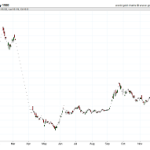The year 2003 saw significant fluctuations in silver prices, with the metal experiencing both highs and lows throughout the year. This article delves into the trends and patterns of silver prices during this period, offering a detailed analysis of the daily prices and factors that influenced them.
The article also provides information on the LBMA Silver Price Auction and forex prices, cautioning against relying solely on online price data and opinions for speculative purposes.
Throughout the article, emphasis is placed on the importance of physical precious metal bullion products for asset preservation and prudent allocation purposes. While the article offers a comprehensive overview of the daily silver prices for each month in 2003, it does not provide an explanation or analysis of the factors influencing silver prices or the silver market and industry.
Instead, the article focuses on presenting data-driven facts and trends, allowing readers to draw their own conclusions and make informed decisions about their investments.
Topic Overview
The text provides a comprehensive overview of silver prices in 2003, including daily price data, fluctuations, and trends. The data presented in the text indicates that silver prices fluctuated throughout the year and reached a peak of $5.70 oz on December 18, 2003, and a low of $4.84 oz on October 7, 2003. Prices were mostly above $5 oz during November and December and mostly below $5 oz during July, August, and September.
The text also provides LBMA silver price fix history data, which is useful in understanding the nature of silver prices in 2003. However, the text does not offer any analysis of the factors influencing these prices or information on the silver market or industry.
A silver market analysis could provide a more comprehensive understanding of the fluctuations and trends observed in silver prices in 2003. Historical silver price trends and patterns could be analyzed to identify key drivers of silver prices, such as supply and demand, geopolitical factors, and economic indicators.
Such an analysis could help investors and analysts make informed decisions about investing in silver and provide a more nuanced understanding of the precious metals market. Overall, while the text provides useful data on silver prices in 2003, a more in-depth analysis of the silver market and industry is necessary to fully understand the dynamics of silver prices.
LBMA Silver Price Auction
One notable aspect of the LBMA Silver Price Auction is its reliance on composite prices arrived at by various trading banks and brokerages, which some may argue could introduce potential biases or inaccuracies in the final price determination.
The process involves multiple rounds of bidding, with participants submitting their proposed prices based on their market knowledge and analysis. The final price is then determined by taking the median of the submitted prices, providing a transparent and fair price determination process.
The impact of the LBMA Silver Price Auction on the global silver market is significant, as it is used as a benchmark for pricing silver products and contracts. The involvement of multiple trading banks in the auction provides a diverse range of market perspectives, ensuring that the final price reflects a broad understanding of the market.
While the reliance on composite prices may introduce some level of bias, the transparent and regulated nature of the auction helps to mitigate this risk, providing a reliable pricing mechanism for the silver industry.
Forex Prices
Forex prices are widely used in the precious metals industry and are continuously traded 24 hours a day, providing market participants with access to real-time pricing information. As the most widely quoted prices in the industry, they are used by investors, traders, and analysts to monitor market trends, develop trading strategies, and make informed investment decisions. Forex silver markets trade around the clock, allowing market participants to react quickly to changing market conditions and news events that may impact silver prices.
To better understand the relationship between forex prices and the silver market, it is important to analyze market trends and develop trading strategies based on this information. By using technical analysis tools and charting software, traders can identify key support and resistance levels, as well as patterns and trends that may indicate potential price movements. This information can then be used to develop trading strategies that take advantage of market opportunities and minimize risk. Overall, understanding how forex prices impact the silver market is essential for anyone looking to invest in this precious metal.
Daily Silver Prices
Can daily data on the value of silver provide insight into market behavior and inform investment decisions?
The daily silver prices from July to December 2003 show significant volatility. The prices fluctuated throughout the year, with a peak of $5.70 oz on December 18, 2003, and a low of $4.84 oz on October 7, 2003. November and December saw mostly prices above $5 oz, while July, August, and September had prices mostly below $5 oz. The prices increased steadily from September to December and decreased steadily from August to October. Prices remained relatively stable from July to August and fluctuated more frequently from September to December.
The impact of global events on silver prices is not provided in the data. However, the fluctuations in silver prices in 2003 suggest that various factors may have influenced the market behavior.
Daily data on silver prices can be useful in understanding trends and identifying patterns that can inform investment decisions. Such information can help investors anticipate market volatility and make informed decisions on when to buy or sell silver.
Price Fluctuations and Trends
The data provided on daily silver prices in 2003 reveals significant changes in the market over time. Silver prices fluctuated throughout the year, reaching a peak of $5.70 oz on December 18, 2003, and a low of $4.84 oz on October 7, 2003. Prices were mostly above $5 oz during November and December, and mostly below $5 oz during July, August, and September. Prices increased steadily from September to December and decreased steadily from August to October. Prices remained relatively stable from July to August and fluctuated more frequently from September to December.
Silver market analysis suggests that geopolitical events can impact silver prices. For example, in 2003, the Iraq War was ongoing, and tensions between the US and North Korea were high. These events could have affected the supply and demand of silver.
However, the data provided does not offer any analysis of the factors influencing silver prices. Nonetheless, it is clear that silver prices in 2003 experienced significant fluctuations, which could have been influenced by a variety of factors, including geopolitical events and supply and demand dynamics in the silver market.
Frequently Asked Questions
What were the main factors influencing silver prices in 2003?
The main factors influencing silver prices in 2003 were supply and demand and investor sentiment. These factors were influenced by global economic conditions, geopolitical events, and changes in the mining industry. For example, the increasing demand for silver in electronics and solar panels contributed to higher prices.
How did silver prices in 2003 compare to prices in previous years?
Silver price stability in 2003 was influenced by the impact of demand, but there is no information on how it compared to previous years. Objective, data-driven analysis of silver prices in other years is needed for comparison.
What were the major players in the silver market in 2003, and how did they impact prices?
Key players in the silver market in 2003 included trading banks and brokerages. Market strategies such as silver fix prices and Forex trading influenced prices. An objective, data-driven analysis of their specific impact on prices is not provided.
What impact did geopolitical events have on silver prices in 2003?
Geopolitical instability and global demand had a significant impact on silver prices in 2003. The invasion of Iraq and tensions in the Middle East increased demand for silver as a safe-haven asset, leading to price fluctuations throughout the year.
What were some of the key trends and developments in the silver industry in 2003?
The silver industry in 2003 saw increased demand from various sectors, including electronics and photography. Mining production also increased, albeit at a slower pace. Overall, the industry experienced moderate growth, with prices fluctuating throughout the year.





